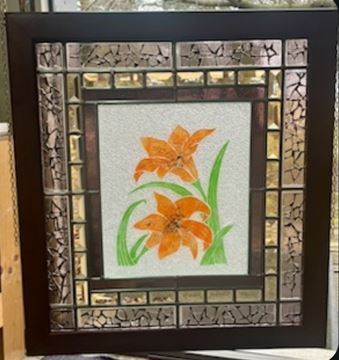Since taking up working with glass over four decades ago, Gordon Hill continues to immerse himself in the medium, creating an array of unique pieces.
Hill, who resides in and operates his Cardinal Glass Studios out of Mount Pleasant, explained his early career and how he eventually got into working with glass.
“I was always artistic and enjoyed crafts and doing things with my hands ever since I was a kid. Eventually, I ended up working at an early age with my father, traveling all over Canada, doing construction,” said Gordon. “After my parents passed away early, I decided to go back to school and get a little bit more education. I got involved with franchises, and really poured my heart and soul into that for about four and a half years. After that, I wanted to get involved in something creative and ended up choosing glass as my medium.”
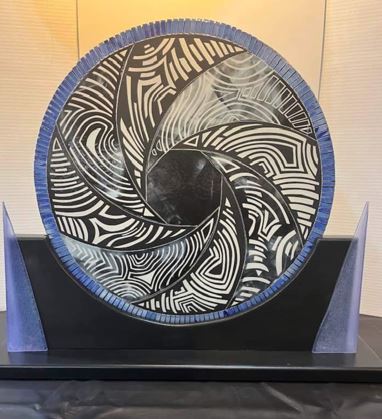
Gordon said he enjoyed working with glass as it gave him freedom and an opportunity to create with a certain measure of control.
“One day, I went to the library and picked up a book on the art and once I started working with glass, I immediately fell in love with it,” he recalled. “I’ve enjoyed working with the medium [and] working with a material that is rigid yet so playful with colour. I realized early on that the only thing I would not have control over was the price of materials…[but, working with glass] would give me a chance to be a free spirit.”
After working on his own for a few years, Gordon moved to Ottawa and found himself learning even more about the art.
“When I moved there, I got into a partnership with two other artists who had been doing glass for about a decade and I learned a lot with them over those next four years. When that [partnership] dissolved, I moved back towards Scotland, Ontario, and I set up a home studio and continued doing commission work and restorations on church windows,” stated Gordon. “I eventually ended up joining a nonprofit organization with the mandate of promoting contemporary stained-glass artists and art in Canada and North America. I then became president [and] for four years I got to meet a lot of different people, worked on developing several workshops and went to many conferences.”
Eventually, Gordon would go on to pass the torch for the leadership of the organization in order to focus on his own work and private commissions.
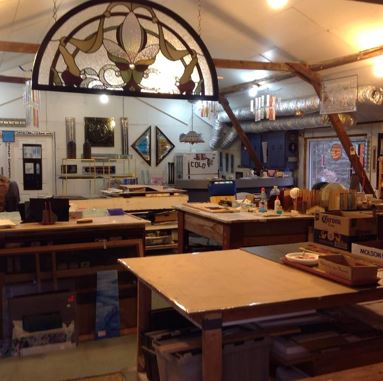
“Normally, I’ll have a customer that calls me up and they want to have a particular stained-glass window for their home or their office. I go on site to take a look at the opening, which helps me determine what direction it will sit, either west or east, and what direction the sun is coming into that room,” he said. “[I make note of] those variables so I can determine the kinds of colours, glass and materials I’m going to be using for the type of atmosphere that’s going to be created. I’ll talk with the customer in regards to what type of design they want; Flowers? Wildlife? Or will it be an abstract? Then I narrow it down to what the customer likes and from that point, I’ll do some preliminary sketches called ‘cartoons.’ Once the drawings get approved, I start to execute the project.”
One of the key elements of the process is selecting and cutting the glass and then putting it all together.
“I then select and cut the glass, and I usually have two cartoons that are duplicates of the same thing. Once I cut the glass, I put all of it on one pattern and then when it’s all laid out and completed, I start the process of letting it up. Once it’s let up, I solder each intersecting lead joint on both sides,” said Gordon. “I use an old European recipe for grout when I cement the window so that it’s waterproof on both sides, giving it much more stability. If it does need support bars or anything of that nature, I’ll attach those then. Once that’s done, I do the final cleanup and polishing of the window and it’s ready for installation.”
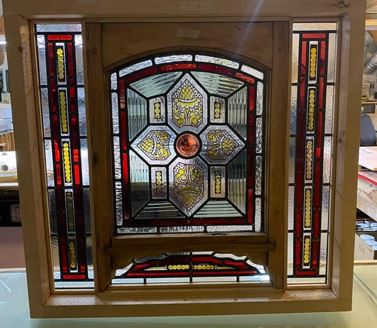
Although Gordon has done many projects for churches over the years, he said that some of the more detailed commercial works were among his favourites.
“I’ve done a lot of churches which have been very fulfilling, [however,] one of the commercial commissions I did was the dining room skylight in the Queens Landing Hotel in Niagara-on-the-Lake. That was an exciting project and a fairly large one at around 700 square feet of cut glass,” said Gordon. “The Olde School Restaurant was another one I did back when I started out; I did some stained-glass windows… the five top windows in the dining room, and then eventually the windows below those ones which had school kids and schoolhouse themes. I ended up doing about 95 per cent of all the glass for them. I also did another project for St. John’s College, I did three panels for their chapel which was also a really interesting commission.”
Gordon, whose glass pieces have been featured in many venues including local galleries such as the Robertson Fine Arts Studio & Gallery and the Paris Bohemian Gallery, spoke about the two most popular glass art techniques.
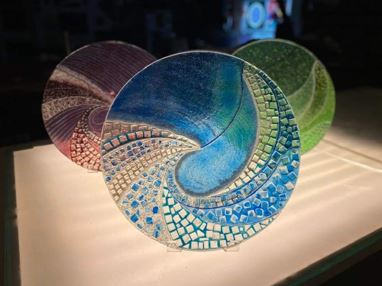
“There’s hot glass where people use the blowpipe and blowing vessels, and then there’s warm glass which is done using sheet glass (stained glass) and the kiln. Fuse glass and warm glass actually go back 4,000 years…King Tut had fused glass jewelry,” said Gordon. “When the blowpipe technique was invented, around 2,500 years ago, it put all the practitioners of warm glass [or fused glass] out of business because it was just one step… you put it in the kiln, it’s annealed and it’s done. Right now, in the North American scene, warm glass is popular…[and] techniques are being developed along contemporary lines. That’s the big thing and it’s related more to functional pieces as well as all wall art, home decor or sculptural work done using the kiln.”
Gordon has also honed his skills in developing rich colors for his glass, which make the end results even more eye-catching and unique.
“I take a piece of window glass and I’ll sift, for example, blue powder on the surface of that glass. I’ll put it in my glass kiln and fire it at around 1,500 degrees Fahrenheit, and I’ll fuse that into the flow glass. At that temperature, it strikes in [and] the blue colour comes out to be either transparent or opaque, depending on what powder I’m using and now I’ve got a nice piece of blue glass,” explained Gordon. “Then I’ll flip it over, and I’ll do the other side in, say, using orange, and I’ll fire that so now I have a colour on both sides. I can then sandblast through the blue with a particular design or motif, and it will show the orange on the other side. That’s called flash glass [and] I do that on both sides so that I can now incorporate two different colours on one piece of glass. It’s a complicated process, but it’s a very interesting one.”
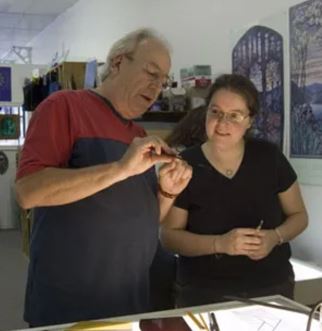
Along with continually developing his artistic skills, Gordon has also been keen on teaching others during the course of his professional career.
“I’ve done a lot of teaching over the years. I started through the Board of Education in Ottawa and the Kentville area when I lived there. When I moved back [to Brant County], I taught at Mohawk College for around 25 years,” he said. “I also taught at the Haliburton School of Fine Arts at Fleming College. Although I haven’t been doing a lot of teaching since I’ve moved my studio where it is now, I’m getting a lot of people interested in doing classes.”
Gordon, who spends his time working from his studio located at 9 Campbell Drive in Mount Pleasant, looks to focus on his creative glass projects while thinking about teaching again.
“I’m not retired, but I don’t do restoration work any longer. I still go to the studio every day [and] I’m now more focused on creating my own glass and experimenting; I’m using a lot of recycled float glass, and I have a big inventory of glass powders that I fuse to the clear glass to make my colour and work with that,” stated Gordon. “I’m also thinking of opening up a whole new gateway [where] I want to teach students on using recycled glass. It’s not as expensive as buying a piece of antique glass from France or Germany, which is one of the reasons that I got involved in recycled glass and making my own colours in the first place.”
